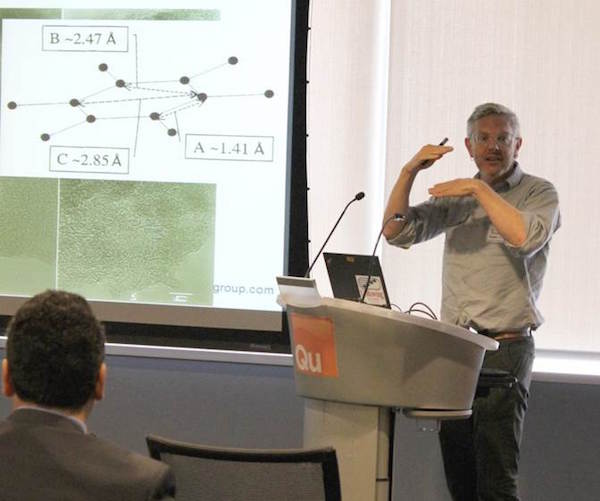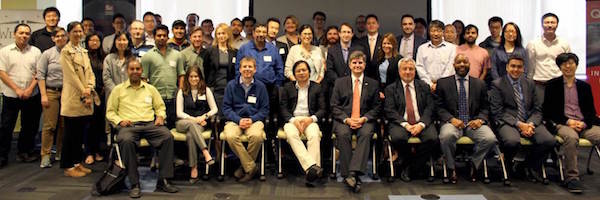Interest in two-dimensional (2D) materials for energy technology, with the potential to positively impact efficiency and environmental sustainability, is rapidly growing. Drexel University and, in particular, the Department of Materials Science and Engineering, is a hub for research into possible advances in 2D materials for energy. As such, Drexel played host to the "Symposium on 2D Transition Metal Compounds for Energy Applications," bringing together 85 participants from 13 different institutions to explore the use of these materials in a variety of energy contexts.
Held on May 1 and 2, the symposium was sponsored by the recently launched Drexel Areas of Research Excellence (DARE) program, a University initiative to support interdisciplinary research across the university, creating innovative, unique, and strategic collaborations at the intersections of existing areas of strength that will lead to transformative outcomes.

Professor Ekaterina Pomerantseva of Drexel Materials presents her work on layered oxides for battery technologies. (Photo credit, Saleesha Sin)
Biologically-Inspired and Resource-Conserving Advanced Materials (BRAVE) is a DARE-funded initiative led by Drexel Materials Department Head and Professor Michele Marcolongo that involves faculty from numerous Drexel colleges and schools. BRAVE is designed to stake out a national leadership role in the synthesis and processing of new materials. The development of novel 2D materials for applications in supercapacitors, batteries, and catalysis, such as the Drexel-discovered MXene family of transition metal carbides and nitrides, is one of the central efforts within the BRAVE initiative. The symposium was an outgrowth of this effort. "The BRAVE symposium was successful in bringing together students, postdoctoral researchers, and faculty," says Marcolongo, "providing an opportunity for research groups to build new collaborations and learn more about cutting-edge materials research at Drexel."
The symposium attracted researchers from universities, national laboratories, and industry to learn about the growing importance of 2D materials and build opportunities for regional collaborations focused on this area. The event consisted of talks from top researchers, including six presentations from Drexel faculty in Materials Science and Engineering, Chemical and Biological Engineering, and Physics, as well as faculty presentations from regional universities including Columbia University, Yale University, the University of Maryland, the University of Pennsylvania, Rutgers University, Penn State University, Temple University, and Johns Hopkins University. A student poster session was held in Drexel's Main Building concurrent with a reception for Professor Yury Gogotsi, who was installed as the Charles T. and Ruth M. Bach Professor on May 1.

Professor Simon Billinge of Columbia University describes advanced techniques for measuring atomic structure in two-dimensional materials. (Photo credit, Saleesha Sin)
"The meeting really highlighted the tremendous potential for two-dimensional materials in a variety of energy technologies," said Gogotsi. "Presentations by investigators at Drexel and other institutions clearly demonstrated the rapidly growing momentum around MXene materials for use in batteries, supercapacitors, and catalysis."
Researchers were not the only ones on-hand to learn from their colleagues. Students also had the opportunity to gain knowledge about ground-breaking research and to network with prominent faculty in the 2D field. The symposium was attended by Drexel undergraduate and graduate students from five different departments, as well as students from Temple University, the University of Pennsylvania, and the University of Maryland. "Two-dimensional materials research has expanded greatly even in my time as a student at Drexel and I always look for opportunities to see alternative perspectives about the field," said Kathleen Maleski, a PhD candidate in Drexel Materials. "This symposium offered just that: a happy medium between a small group meeting and a large conference; it was a chance to explore things you didn't know before, yet also an opportunity to network with presenters."
Co-PI on BRAVE, Drexel Materials associate professor Steven May, organized the meeting and emphasized the significance of these materials. "Two-dimensional materials are really exciting because they can have properties that differ dramatically from their three-dimensional counterparts," May shared. "Researchers showed how the atomically thin nature of 2D materials makes them great candidates for applications that require lots of surface area, such as catalysis or electrodes for supercapacitors." Summarizing the importance of the symposium, he offered, "We are fortunate to have such great colleagues at so many institutions working on these problems and look forward to the next chapter in 2D materials research for energy."

BRAVE Symposium participants gather for a group shot. (Photo credit, Saleesha Sin)